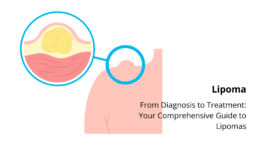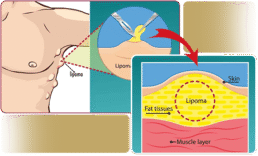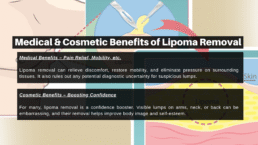What Is a Lipoma?
A lipoma is a soft, fatty lump that grows beneath the skin. It’s non-cancerous and typically painless. Though usually harmless, some people choose lipoma removal for cosmetic reasons or due to discomfort caused by its location.
Why Consider Lipoma Removal?
People seek lipoma removal when the lump grows larger, causes pain, restricts movement, or becomes cosmetically concerning. In rare cases, testing may be needed to rule out liposarcoma, a cancerous tumor.

Understanding Lipomas (What, Why & How)
What Causes Lipomas?
The exact cause of lipomas remains unclear, but genetic factors and family history play a strong role. Injuries or trauma to fatty tissue may also contribute to their formation.
Who Is at Risk of Developing a Lipoma?
Lipomas are more common in adults between 40 and 60, but anyone can develop them. Those with familial multiple lipomatosis are especially prone to forming several lipomas over time.
Types of Lipomas and Their Characteristics
There are various types like angiolipoma (painful), fibrolipoma (firm), and spindle cell lipoma (more fibrous). Proper diagnosis ensures the right treatment approach and avoids unnecessary concern.
How to Differentiate Between a Lipoma and Other Lumps?
Lipomas are soft, movable, and slow-growing. Unlike cysts or malignant tumors, they rarely cause redness or rapid growth. A professional evaluation confirms the nature of the lump.
Diagnosis & Evaluation
When to See a Doctor for a Lipoma
If the lump grows, feels painful, or changes in shape or color, consult a doctor. Early diagnosis helps rule out any underlying conditions requiring medical attention.
Diagnostic Tests for Lipoma Confirmation
Doctors typically diagnose lipomas through physical examination. In some cases, imaging like ultrasound or MRI is used, especially when the lump is deep or unusually large.
When Is Lipoma Removal Necessary?
Lipoma removal becomes necessary when the growth causes discomfort, cosmetic concerns, or restricts movement. Doctors may also recommend removal if malignancy is suspected.
Lipoma Removal Procedures (MECE Breakdown)
Surgical Excision – The Most Common Method
Surgical excision involves making a small cut and completely removing the lipoma. It is the most effective and permanent solution, usually performed under local anesthesia.
Liposuction for Lipoma – A Less Invasive Option
Liposuction is used when the lipoma is soft and located in areas with minimal risk. It’s less invasive but has a slightly higher chance of recurrence than excision.
Minimal-Incision Extraction – Cosmetic Approach
This technique uses a smaller incision for a cleaner cosmetic result. It’s suitable for small lipomas and commonly offered at a specialized lipoma removal clinic in Newcastle.
Laser-Assisted Lipoma Removal – Is It Effective?
Laser methods reduce scarring and bleeding. However, they’re typically combined with other techniques rather than used alone. It’s best for surface-level, small lipomas.
Non-Surgical Approaches – Do They Work?
Creams and natural remedies are often ineffective. While harmless, these methods don’t remove lipomas. Professional evaluation remains the best course for permanent results.

Choosing the Right Option
How to Decide the Best Method for Your Lipoma?
The choice depends on the lipoma’s size, location, and whether it causes pain. A consultation with a qualified surgeon will help you decide on the safest and most suitable method.
Factors That Influence the Choice of Treatment
Important factors include the lipoma’s depth, cosmetic impact, cost, and your health condition. Discussing these with your doctor will narrow down the right removal technique.
Medical & Cosmetic Benefits of Lipoma Removal
Medical Benefits – Pain Relief, Mobility, etc.
Lipoma removal can relieve discomfort, restore mobility, and eliminate pressure on surrounding tissues. It also rules out any potential diagnostic uncertainty for suspicious lumps.
Cosmetic Benefits – Boosting Confidence
For many, lipoma removal is a confidence booster. Visible lumps on arms, neck, or back can be embarrassing, and their removal helps improve body image and self-esteem.
Prevention of Future Complications
Early removal prevents the lipoma from growing and pressing on nerves or blood vessels. It also avoids the need for more extensive surgery later.

Risks & Side Effects
Common Side Effects Post Removal
Minor swelling, bruising, or scarring may occur after the procedure. These effects usually subside within a few days with proper care and medication.
Rare but Serious Complications to Watch For
Infections, hematoma, or recurrence are rare but possible. Choosing an experienced provider for lipoma tumor removal in Newcastle can significantly reduce such risks.
Cost Breakdown
Lipoma Removal Cost in UK & Other Regions
Costs vary: £400–£1,500 in the UK. Factors like technique, clinic, and surgeon’s experience influence pricing.
Also, at Eldon Aesthetics, costs vary by location and size:
- Body: Starts from £399 (up to 1.5 cm) and goes up to £899 (5.6–7 cm).
- Scalp: From £399 to £799, based on dimensions.
- Face/Groin/Neck: Between £399–£799 depending on size.
- Lips/Oral cavity: Start from £499.
- Multiples: Discounts available for 2nd, 3rd, or 4th lipomas.
A consultation is included in the package, offering clarity on your specific lipoma removal cost.
Factors That Affect the Total Cost
The number of lipomas, size, location, and need for specialized tools all affect cost. Hospital or clinic reputation also plays a key role in pricing.
Insurance Coverage – Is Lipoma Removal Covered?
Insurance may cover lipoma removal if it’s deemed medically necessary. Cosmetic removals are usually not covered, so always check your policy before booking a procedure.
Recovery & Aftercare
What to Expect Immediately After Surgery
You may experience slight soreness or tightness in the treated area. Most people return home the same day with basic aftercare instructions and a dressing over the wound.
Tips for Faster Recovery
Keep the area clean, avoid heavy activity, and follow your doctor’s advice. Applying ice and taking prescribed medication can help reduce swelling and discomfort.
Post-Operative Care Instructions
Follow wound care steps, attend follow-up appointments, and report any signs of infection. Most wounds heal within 7 to 10 days without complications.
When Can You Resume Daily Activities?
Light activities can usually be resumed within 24 to 48 hours. Avoid exercise and lifting heavy objects for about a week to support proper healing.
Warning Signs of Infection or Recurrence
Watch out for pus, increased redness, or a return of the lump. If symptoms arise, seek help from professionals offering lipoma removal in Newcastle or nearby clinics.

Long-Term Outcomes & Recurrence
Will the Lipoma Come Back?
Recurrence is rare after surgical removal, but liposuction has slightly higher rates. Multiple lipomas may continue appearing in genetically predisposed individuals.
Preventive Measures for Recurrence
Though there’s no surefire prevention, maintaining a healthy lifestyle and regular check-ups can help detect any new growths early on.
Choosing the Right Surgeon or Clinic
What to Look for in a Specialist
Look for board certification, patient reviews, and experience in soft tissue procedures. Clinics specializing in minor surgery typically offer better outcomes.
Questions to Ask Before Scheduling Surgery
Ask about the procedure, recovery time, success rate, and aftercare support. Visiting a dedicated lipoma removal clinic Newcastle ensures you’re in safe hands.
Conclusion
Lipoma removal is a safe and effective solution for both medical and cosmetic reasons. With minimal recovery time and proven results, it helps restore comfort and confidence. Choose a trusted provider and discuss your options thoroughly to ensure the best outcome.
FAQs
- Can I live with a lipoma without removing it?
Yes, if it’s painless and small, but monitoring is important. - Is lipoma cancerous or dangerous?
Most lipomas are benign and harmless. - How painful is lipoma removal?
The procedure is usually pain-free with local anesthesia. - How long does it take to heal?
Recovery typically takes 7–10 days. - Can lipoma be treated with home remedies?
No, removal requires medical intervention. - Is scarring common after removal?
Minimal scarring may occur, depending on technique. - Can children develop lipomas?
Yes, though it’s more common in adults.
